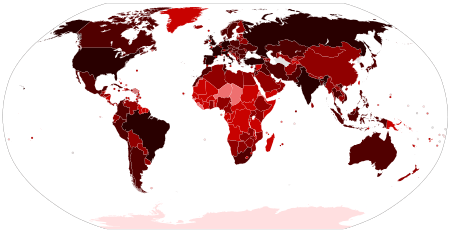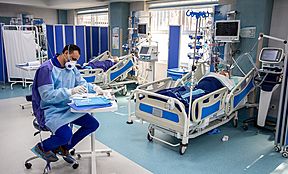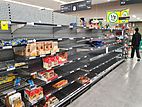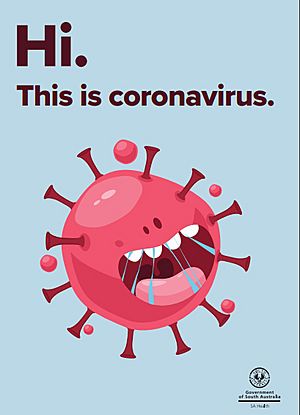2019–20 coronavirus pandemic facts for kids
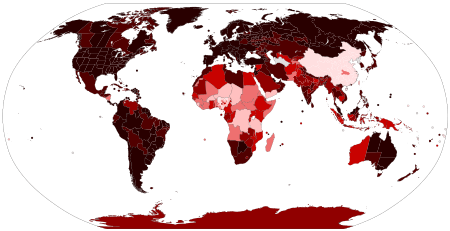
|
|||||||
|
|||||||
| Disease | Coronavirus disease 2019 (COVID-19) | ||||||
|---|---|---|---|---|---|---|---|
| Virus strain | Severe acute respiratory syndrome coronavirus 2 (SARS-CoV-2) |
||||||
| Location | Worldwide (list of locations) | ||||||
| Date | Nov / Dec 2019 – ongoing (4 years, 4 months and 4 weeks) |
||||||
| Confirmed cases | 1,196,553 | ||||||
| Recovered | 246,108 | ||||||
|
Deaths
|
64,549 | ||||||
|
Territories
|
209 | ||||||
The 2019–20 coronavirus pandemic is an ongoing pandemic of coronavirus disease 2019 (COVID-19), caused by severe acute respiratory syndrome coronavirus 2 (SARS-CoV-2). The outbreak was first found in Wuhan, Hubei, China, in December 2019, and was declared a pandemic by the World Health Organization (WHO) on 11 March 2020. The International Committee on Taxonomy of Viruses named the virus "severe acute respiratory syndrome coronavirus 2" (SARS-CoV-2).
The virus is usually spread from one person to another via lung related small drops produced during coughing or sneezing. It mostly spreads when people are close to each other but can also spread when people touch a contaminated surface and then their face.
Ways people can avoid spreading the virus include hand washing, covering the mouth when coughing, maintaining distance from other people, and monitoring and self-isolation for people who think they are infected.
The disease has since evolved into a pandemic. According to the European Centre for Disease Prevention cases of COVID-19 have been reported from many countries in the world and also cruise ships.
The outbreak may have came from a coronovirus that usually lives in bats that infected pangolins and then changed inside the pangolins until it could infect humans
Contents
Symptoms
Common symptoms include fever, cough, and shortness of breath. Complications may include pneumonia and acute respiratory distress syndrome. There is currently no vaccine or specific antiviral medicine for COVID-19. Right now, doctors usually give patients supportive therapy.
What can kids do to help
Adults are doing a lot to keep children and adults safe so there's no need for kids to worry, but kids can play a part in reducing the spread of the virus by doing these things.
- Make sure you wash your hands, by using lots of soap and rubbing your hands together to clean all your fingers, under the fingernails and between the fingers. Sing the "ABCs" or the "happy birthday" song a couple of times while you wash your hands for about 20 seconds.
- Cover your mouth when coughing, maintaining a distance from other people (particularly those who are unwell).
- try not rub your eyes or nose or put your hands in your mouth.
If you have to stay home here's some activities you can do.
There's a great Coronavirus book for kids by the South Australian government about what the coronavirus is and how they can help stop its spread.
Other pages
- Isolation (health care)
- Homeschooling during coronavirus 2020
- Easter Egg Hunt With Social Distancing in 2020
- N95 mask
Images for kids
-
Deceased in a refrigerated "mobile morgue" outside a hospital in Hackensack, New Jersey, U.S., in April 2020.
-
Gravediggers wearing protection against contamination bury the body of a man suspected of having died of COVID-19 in the cemetery of Vila Alpina, east side of São Paulo, in April 2020.
-
A nurse at McMurdo Station sets up the polymerase chain reaction (PCR) testing equipment, in September 2020.
-
Goals of mitigation include delaying and reducing peak burden on healthcare (flattening the curve) and lessening overall cases and health impact. Moreover, progressively greater increases in healthcare capacity (raising the line) such as by increasing bed count, personnel, and equipment, help to meet increased demand.
-
A highway sign discouraging travel in Toronto in March 2020
-
A temporary hospital constructed in Wuhan in February 2020.
-
Vaccinations at a retirement home in Gijón, Spain, in December 2020.
-
The hospital ship USNS Comfort arrives in Manhattan on 30 March 2020.
-
US Air Force personnel unload a C-17 aircraft carrying medical supplies in Niamey, Niger, in April 2020.
-
Ukraine evacuates Ukrainian and foreign citizens from Wuhan, China.
-
World Health Organization representatives holding joint meeting with Tehran city administrators in March 2020.
-
An American Catholic military chaplain prepares for a live-streamed Mass in an empty chapel at Offutt Air Force Base in March 2020.
-
Students take end-of-year exams in Tabriz, Iran, during the pandemic.
-
The "Wee Annie" statue in Gourock, Scotland, was given a face mask during the pandemic.
See also
 In Spanish: Pandemia de COVID-19 para niños
In Spanish: Pandemia de COVID-19 para niños


